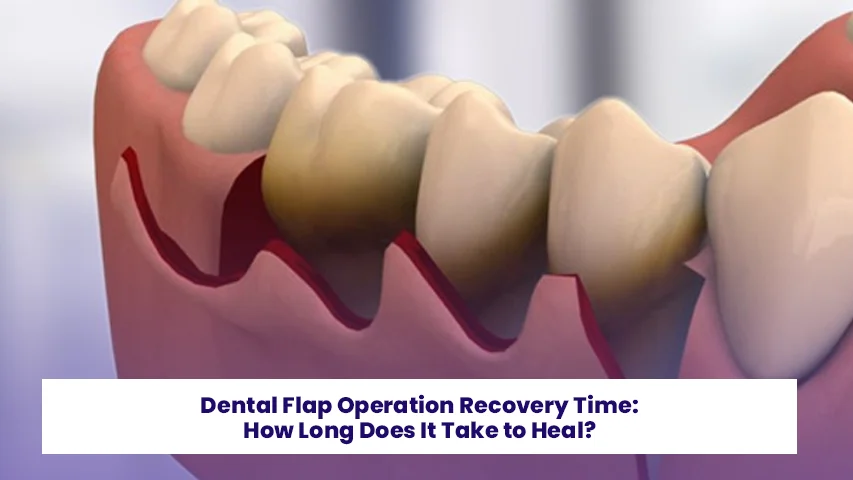
The Best Tips for Preventing Bad Breath
10 September 2025
Dental Flap Operation Recovery Time: How Long Does It Take to Heal?
18 September 202510 Signs You Might Need a Root Canal Treatment
When a natural tooth is severely infected or damaged, a root canal treatment is a common and effective dentistry procedure that is performed to save it. Although many people avoid seeking treatment for root canals because of the associated pain, modern dentistry is equipped with effective and effortless methods to widen a root canal, alleviate discomfort, and get rid of the pain while preserving your oral health and smile. But how do you know when it’s time to see your dentist and consider this option?
For you to act on time, let’s review the symptoms to look out for that need this procedure. Understanding these signs, along with details such as root canal treatment steps, potential discomfort, and even root canal treatment price, can help you make informed decisions for your dental health.
Signs That You Need Root Canal Treatment

1. Persistent Toothache
For sure, one of the telltale signs in the dental health sphere is ceaseless toothache, which suggests the need for a root canal procedure. An ache of low intensity that hangs around after the consumption of sugary edibles is of no great concern. To put the matter in clearer perspective, an ache that assumes the form of a persistent, sharp stabbing or throbbing pain is of greater concern and should be investigated for the underlying cause. The assumption of a painful form by tooth ache is worrisome in the sense that the underlying cause is the infection or inflammation of a tender and sensitive portion of the tooth known as pulp, which is characterised by the presence of nerves and blood vessels.
Discomfort in the teeth can be due to a dull, nagging ache or an excruciating sharp pain. This kind of dental problem can make eating, sleeping, or even talking unbearable. While tooth sensitivity with certain food is quite common, perpetual tooth pain is a cause for greater concern. Consulting a dental practitioner early should be emphasised as it greatly enhances the chances of opting for mild teeth root canal treatment to address the issue before the severity of the problem increases.
2. Sensitivity to Hot and Cold
Ever felt that sharp jolt of pain after sipping coffee or biting into ice cream? That sting should fade, but when it doesn’t, it could be a warning sign of damage to your tooth’s pulp. Normally, tooth sensitivity fades quickly once the cause is removed. But, if the pain sticks around and gets worse, it might mean that the tooth’s nerve is exposed because of tooth decay or infection.
When the layers of the tooth are damaged, the hot or cold food and drinks can reach the inner pulp and cause irritation to the nerves. This kind of sensitivity is a typical sign that your tooth could be too damaged for a simple filling. At this stage, a dentist might recommend starting the root canal treatment steps to remove the infected pulp, clean the canal, and seal the tooth for long term protection.
3. Swollen or Tender Gums
Do not disregard any signs of swelling and inflammation of the gums marked by redness and tenderness. Such symptoms point to the infection of the root of the tooth. The small bump dental abscess less than a centimeter can also form which can discharge pus leading to a foul taste in the mouth.
Gum swelling and tooth sensitivity are common symptoms that hinder one to perform daily activities. If left untreated, the infection may spread and affect the bone structure and teeth around it. These problems can be avoided with early detection of the infection and having root canal treatment to save the tooth instead of extracting the tooth.
4. Darkening of the Tooth
Every person’s teeth naturally vary in shade, but a sudden shift in the shade, especially to a dark gray or black color, is cause for concern. This discoloration usually occurs when the pulp tissue inside the tooth is dying or is already dead. Stains that develop as a result of the tissue breaking down can’t be fixed by regular brushing.
In the case of discoloration caused by internal damage, a simple teeth whitening procedure will not suffice. The issue has to be tackled first, which a dentist will assess. Before proposing to fix the tooth’s appearance with a crown or veneer, a root canal treatment of the decayed pulp may be necessary.
5. Pain When Chewing or Touching the Tooth
A sharp pain on a particular tooth when biting down on food or even touching it, likely points towards an infected or inflamed pulp or bone. This type of pain is usually due to some kind of infection inside the tooth. Chewing becomes difficult; even light pressure while brushing or tapping the tooth causes pain.
What starts off as a small ache can eventually make eating difficult and allow the infection to spread. With a teeth root canal treatment, the infection can be removed along with the infected pulp. This allows for the tooth to be sealed and you can once again enjoy eating without pain. This procedure also helps in preserving the natural bite and preventing future problems.

6. Gum Abscess or Pus Discharge
An abscess reveals an infected tooth and is defined as a collection of pus caused by a bacterial infection. It may be detected through swelling, a foul taste in the mouth, or visible pus oozing from the gums near the tooth. Most commonly, the infection is an abscess infection that has spread from the root, which indicates advanced decay or damage to the pulp.
In these circumstances, antibiotics do not solve the issue. As the infection spreads, root canal therapy is often required to remove the focus and properly irrigate the infected canal. Such a procedure is essential in managing infections since it properly treats the problem unlike other methods that are focused only on symptoms. This approach helps in the prevention of recurrence of the infection or spread to other areas.
7. Cracked or Chipped Tooth
An accidental injury, a fall, or a sudden bite on food can lead to a cracked or chipped tooth. Lesser damage can be superficial. But damage can be severely detrimental if the fracture exposes the inner pulp leading to bacteria and infection. Damage to the pulp puts the tooth at risk and can lead to major consequences if ignored.
A chipped tooth that causes discomfort needs to be checked by a dentist as soon as possible. If the damage is severe, the dentist may recommend a root canal therapy to prevent the tooth from extraction. The procedure serves a dual purpose, restoring the tooth’s function and preserving the natural tooth, which is later protected with a crown.
8. Prolonged Tooth Sensitivity to Pressure
Most individuals encounter sensitivity when exposed to heat or cold. However, certain persons undergo discomfort whenever any form of pressure is exerted, be it during chewing or simply touching the tooth with the tongue. If this particular type of sensitivity remains for several weeks, it is a major indication of possible infection or inflammation of the pulp.
As a form of diagnosis, dentists conduct percussion tests for evaluation. This involves tapping the tooth to check the level of pain. When the pressure sensitivity not only continues but also deteriorates, simple remedies can no longer fix it. At this stage it ceases to be functional, root canal treatment becomes the only solution to remove the infection and to remove the ongoing discomfort associated with the tooth.
9. Severe Decay Reaching the Pulp
Cavities that go untreated will eventually reach the pulp chamber, which houses the nerves and blood vessels. Once the decay reaches this point, fillings won’t work anymore. The bacteria will then invade the pulp, which results in pain, infection, and sometimes abscesses.
If your dentist notices during the examination or X-rays that the decay has reached the pulp, they will immediately advise a root canal. This is to prevent further infection and the loss of the tooth. Despite the concerns that patients may have regarding the pain of a root canal, the comfort of modern anaesthetics and the procedures used today are both effective and efficient.
10. Tooth Mobility or Loosening
An adult’s healthy tooth should stay securely attached in the bone. A tooth loosening or shifting in position may be a sign of infection or inflammation of the surrounding bone. Infection, if left untreated, weakens the bone and ligaments securing the tooth.
A root canal may be useful in these situations to cure the infection, after which the tooth can be restored with a crown for stability. Not every loose tooth is salvageable, but the sooner you act, the better your odds of retaining your natural smile without the need for extraction and replacement.
Understanding the Process

Most patients experience anxiety regarding procedures, but understanding the steps of a root canal treatment can ease concerns. In general, the treatment begins with numbing the area, followed by the extraction of the infected pulp. The canals are then cleaned and disinfected, and the tooth is completed and sealed with a crown, both for protection and strength.
The purpose of this treatment is to relieve pain and also avoid reinfection. The procedure, due to modern dental technology, is not as painful as people imagine it to be, as the pain is equal to or less than that experienced during a dental filling. Patients tend to appreciate how painless and fast the treatment is in contrast to the anxiety they experience before it begins.
Cost and Expectations
Another concern for patients is the root canal treatment price. The pricing changes depending on the complexity of the case, the tooth involved, and even the dental clinic’s location. Front teeth usually cost less because of fewer roots. Molars are pricier because of multiple canals.
Even though the price might be high initially, saving your natural tooth tends to be more pocket friendly when compared to prosthetic dental surgery. For most patients, a root canal treatment is a smart investment for long term dental health because it is comfortable, functional, and aesthetically superior to implants or bridges.
Spotting even a few of the red flags in this checklist can greatly help you maintain your oral health. Consider constant aching and sensitivity, a persistent tingle, swelling, a change in colour, or a rocking tooth; these red flags are numerous and each of them signals a bigger problem that should be dealt with immediately. Each one can be a pointer to a different problem. Promptly seeing your dentist and getting informed about what is a root canal treatment can help deal with your issues. Many people are concerned about the pain associated with root canal treatment. However, in reality, the procedure has been made virtually pain free, safe, and effective with modern techniques. The root canal treatment for teeth and its associated costs and recovery period should be well understood in order to approach the procedure with the greatest degree of ease. The smile that one cherishes can be best protected with the earliest intervention.













